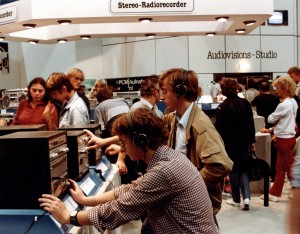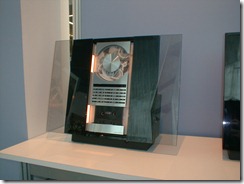I have written some other posts about the Consumer Electronics Show 2010, mainly about the rise of Android and about Skype being integrated in to regular TV sets. But this is the main post about what has been going on at this show.
TV technologies
The main technologies that were present at this year’s Consumer Electronics Show were those technologies related to the TV set.
US consumers are in a TV upgrade cycle due to the country undergoing a digital TV switchover and are preferring flatscreen sets over CRT sets. This is even though there are digital-TV set-top boxes being made available at very cheap prices and through government subsidy programs. The main reality is that the older sets will be “pushed down” to applications like the spare bedroom with the newer sets being used in the primary viewing areas.
Screen Technologies
The main technology that is capturing the CES show floor is 3D TV. This has been brought on by the success of “Avatar” and requires a 3D-capable TV and, for Blu-Ray discs, a 3D-capable Blu-Ray player. In the case of broadcast content, some HD-capable set-top boxes and PVRs that are in the field can be upgraded to 3D functionality through an “in-the-field” firmware update.
In most cases, viewers will need to wear special glasses to view the images with full effect and most implementations will be base on the “RealD” platform. Some eyewear manufacturers are even jumping in on the act to provide “ready-to-wear” and prescription glasses for this purpose.
Vizio had also introduced a 21:9 widescreen TV even though activity on this aspect ratio had become very dormant.
Blu-Ray
The US market has cracked key price marks for standalone lounge-room players and there is an increase in the supply of second-tier models, especially integrated “home-theatre-in-box” systems and low-cost players.
US ATSC Mobile DTV standard
You may not be able to get away from the “boob tube” at all in America with portable-TV products based on the new ATSC Mobile digital TV standard which has been released to the market this year.
LG are launching a mobile phone and a portable DVD player with mobile DTV reception capability. They are also releasing a mobile ATSC DTV tuner chip that is optimised for use in in-car tuners, laptops and similar designs. Vizio are also releasing a range of handheld LED-backlit LCD TVs for this standard.
A key issue that may need to be worked out with this standard is whether an ATSC Mobile DTV device can pick up regular over-the-air ATSC content. This is more so if companies use this technology as the TV-reception technology for small-screen transportable TVs typically sold at the low-end of the TV-receiver market. It is also of concern with computer implementations where a computer may be used as a “one-stop entertainment shop” with TV-reception abilities.
There is a small Mobile-DTV – WiFi network tuner, known as the Tivit, that was shown at the CES. It is a battery-operated device that is the size of an iPhone and uses the WiFi technology to pass mobile TV content to a laptop, PDA or smartphone that is running the appropriate client software. It has a continuous “battery-only” run-time of 3 hours but can be charged from a supplied AC adaptor or USB port. I consider this product as being a highly-disruptive device that could be deployed in, for example, a classroom to “pass around” TV content, but it also has its purpose as something to show the ballgame on a laptop during the tailgate picnic. The main question I have about this is whether it can be a DLNA broadcast server so that people can use them with any software or hardware DLNA-based media playback client.
Network-enabled TV viewing
This now leads me to report on what is happening with integrating the TV with the home network.
More of the “over-the-top” IPTV and video-on-demand solutions (Netflix, CinemaNow, Hulu, etc) are becoming part of most network-enabled home video equipment. In the US, this may make the concept of “pulling out the cable-TV cable” (detaching from multichannel pay-TV services) real without the users forfeiting the good content. They could easily run with off-the-air network TV or basic cable TV and download good movies and television serials through services like Netfilx or Hulu.
The main enabler of this would be the “Smart TVs” which connect to the home network and the Internet, thus providing on-screen data widgets, YouTube integration, DLNA content access, as well as the “over-the-top” services. Even so, the TV doesn’t necessarily have to have this functionality in it due to peripheral devices like home-theatre receivers (Sherwood RD-7505N) and multimedia hard disks (Iomega ScreenPlay Director HD) having these functions. Of course, games consoles wouldn’t be considered complete nowadays unless they have the functionality.
RF-based two-way remote control
Some home-AV manufacturers are moving away from the regular one-way infrared remote control, mainly in order to achieve increased capability and increased reliability. These setups are typically in the form of a hardware remote control or software remote control application that runs on a smartphone and they use Bluetooth as a way of communicating with the device.
These setups will typically require the customer to “pair” the remote control or the smartphone as part of device setup, which will be an experience similar to pairing a Bluetooth headset with a mobile phone. They have infra-red as a user-enabled fallback method for use with universal remote controls, but this could at least foil the likes of disruptive devices like “TV Turn-Off”.
The main driver behind this form of two-way remote control is to provide a secondary screen for interactive video such as BD-Live Blu-Ray discs. Infact, Michael Jackson’s “This Is It” Blu-Ray disc implements this technology in the form of an iPhone app which links with certain Blu-Ray players to use the iPhone’s user interface as a jukebox for the title.
Smartphones and MIDs
Previously, I had done a blog article on the rise of the Android platform as a challenger to the Apple iPhone market share as far as smartphones are concerned.. There is even talk of Android working beyond the smartphone and the MID towards other device types like set-top boxes and the like, with some prototype devices being run on this operating system.
There is an up-and-coming MID in the form of the Adam Internet Tablet MID. This Android-based unit which can link to WiFi netwoks and has a 32Gb SSD, also has a new display-type combination in the form of an anti-glare LCD / e-ink display
This year. the “smartbook” is gaining prominence as a new general-purpose computing form factor. It is a computer that looks like a netbook but is smaller than one of them. It is powered by an ARM-processor abd could run integrated 3G or cellular calls; and its functionality is more equivalent to that of a smartphone.
There have been some E-book readers shown but these are mostly tied to a particular publisher or retail chain.
Connected Car Media
Pioneer and Alpine have equipped their top-of-the-line multimedia head units with “connected radio” functionality. This function works with a USB-tethered iPhone running the Pandora Internet Radio app. Both these solutions act as a “controller” for the Pandora app, with the iPhone pulling in the online content through that service. The Pioneer solution also offers a “virtual-DJ” function in the form of an extended-functionality app that works alongside iTunes. All these solutions are intended to appeal to the young fashion-conscious male who sees the iPhone as a status symbol and likes to have his car “thumping” with the latest tunes. These solutions don’t seem to go anywhere beyond that market, whether with other mobile-phone platforms or other online-media applications like Internet-radio streams.
Ford have developed the MyFord sophisticated dashboard and online telematics system and were demonstrating it at this show. This will work with a user-supplied 3G modem and also supports WiFi router functionality. Typically, this will be rolled out to the top-end of Ford’s US market, such as the Lincoln and Mercury vehicles.
Digital Photography
The new cameras of this year have seen improved user-interfaces, including the use of touchscreen technology and some manufacturers are toying with the use of fuel-cell technology as a power-supply method.
As far as network integration goes, Canon have enabled their EOS 7D digital SLR with this functionality once equipped with the optional Canon WiFi adaptor. This solution even provides for DLNA media-playback functionality.
The aftermarket Eye-Fi WiFi SD memory card was shown as a version, known as the Pro Series, that can associate with 802.11n networks.
The unanswered question with network-enabled digital photography hardware is how and whether these solutions will suit the needs of many professional photographers. The main questions include whether the units will associate with many different wireless networks that the photographer visits without them having to re-enter the network’s security parameters. Another question is whether these solutions can work with higher-security WPA2-Enterprise networks, which is of importance with photographers working in most business, government and education setups.
Computer equipment
“New Computing Experience” alive and well in the US market. Market interested in powerful lightweight laptops that are slightly larger than netbooks. These will be driven by processors that are energy-efficient but are powerful. They could become an all-round portable computer that could appeal to college students and the like or simply as a desktop replacement. The machines that I think of most with this market are the Apple Macbook Pro comoputers that are in circulation, the HP Envy series or the smaller VAIO computers.
Nearly all of these computers that are being launched at the show are running Windows 7, which shows that the operating system will gain more traction through the next system-upgrade cycle.
USB 3.0
There has been some more activity on the USB 3.0 SuperSpeed front.
Western Digital had released an external hard disk that works on this standard, which is known as the MyBook 3.0. This my typically be slow as far as peripherals go because of not much integration in to the computer scene. VIA have also shown a USB 3.0 4-port hub as a short-form circuit, but this could lead to USB 3.0 hubs appearing on the market this year.
ASUS and Gigabyte have released motherboards that have USB 3.0 controllers and sockets on board. These may appeal to system builders and independent computer resellers who may want to differentiate their desktop hardware, as well as to “gaming-rig” builders who see USB 3.0 as bragging rights at the next LAN party. None of the laptop OEMs have supplied computers with USB 3.0 yet.
As far as the general-purpose operating systems (Windows, MacOS X, Linux) go, none of them have native USB 3.0 integrated at the moment but this may happen in the next service lifecycle of the major operating systems.
Some more benefits have been revealed including high-speed simultaneous data transfer (which could benefit external hard disks and network adaptors) and increased power efficiency, especially for portable applications.





